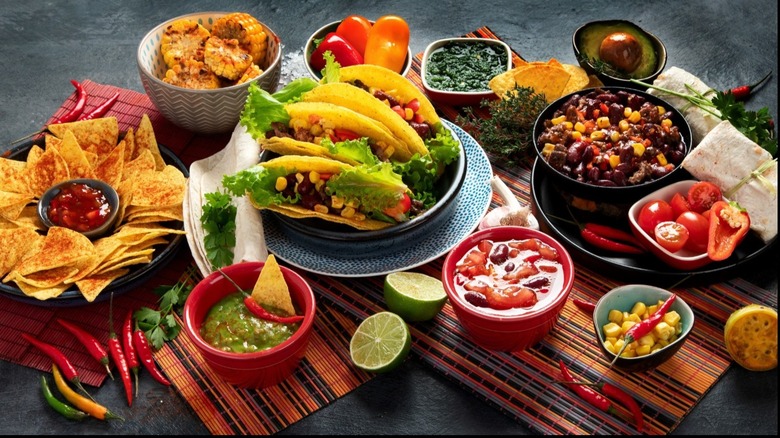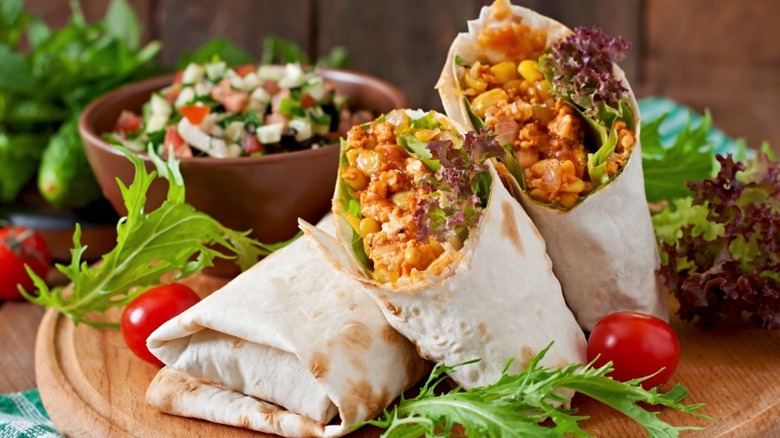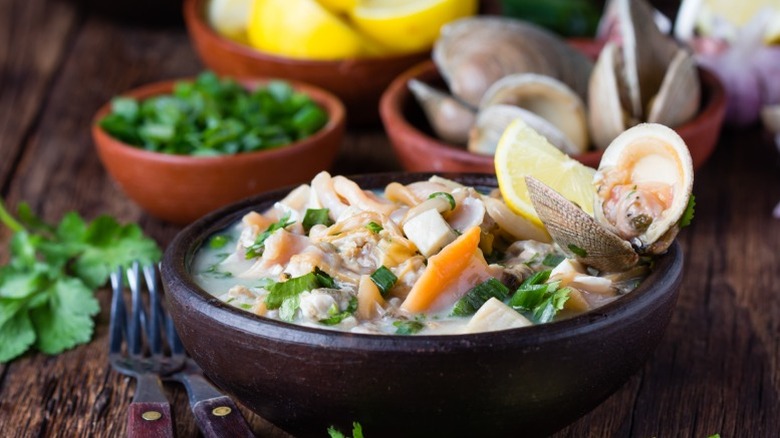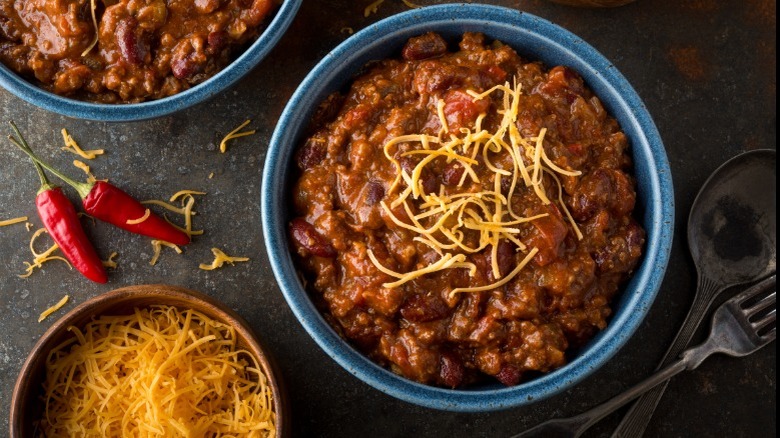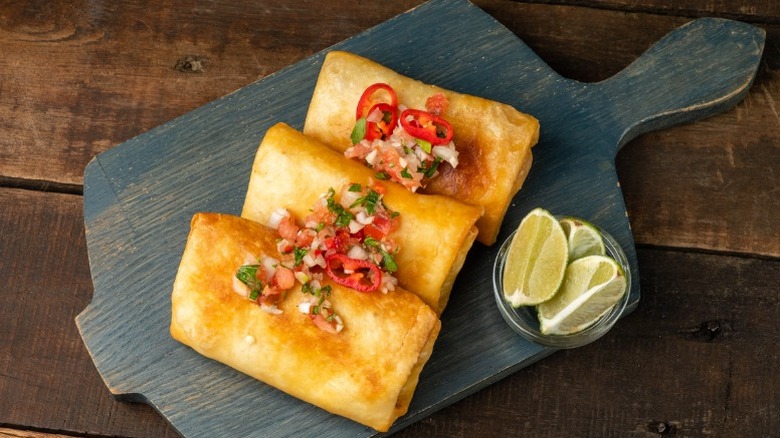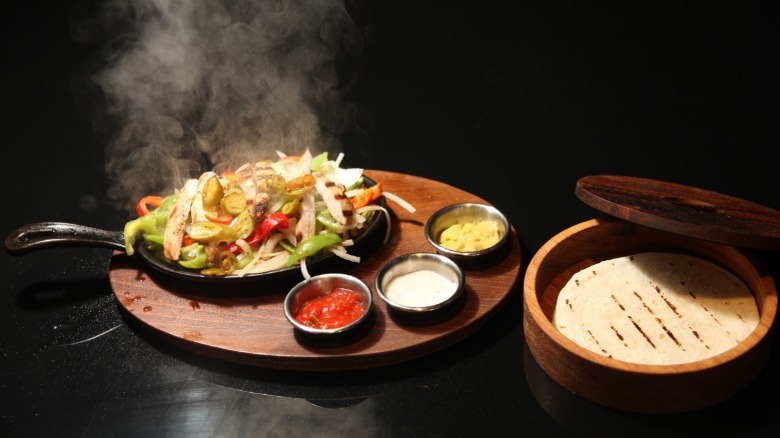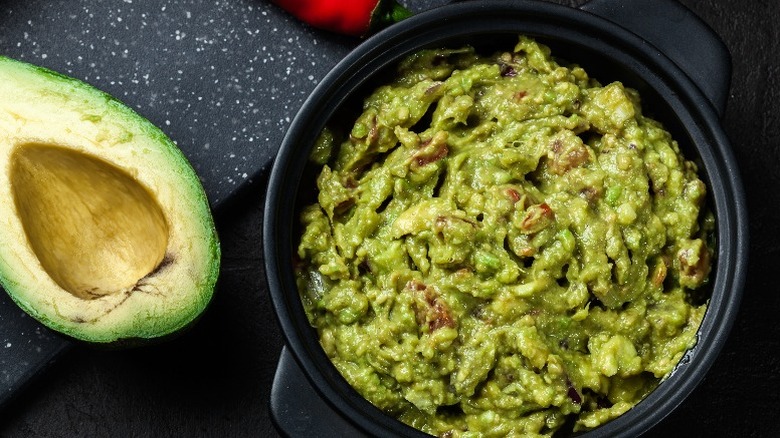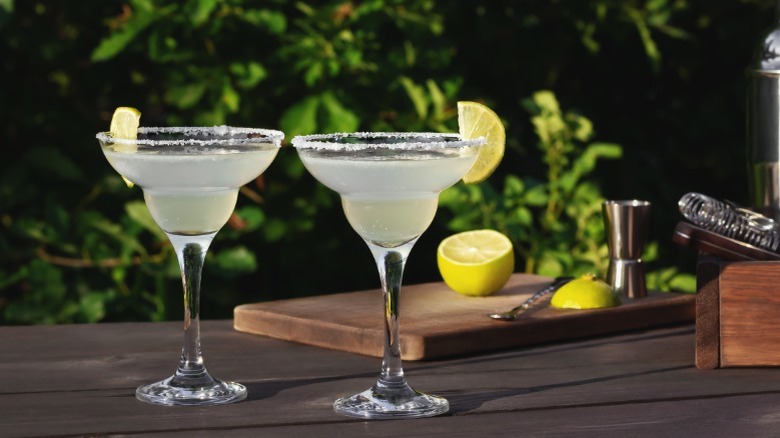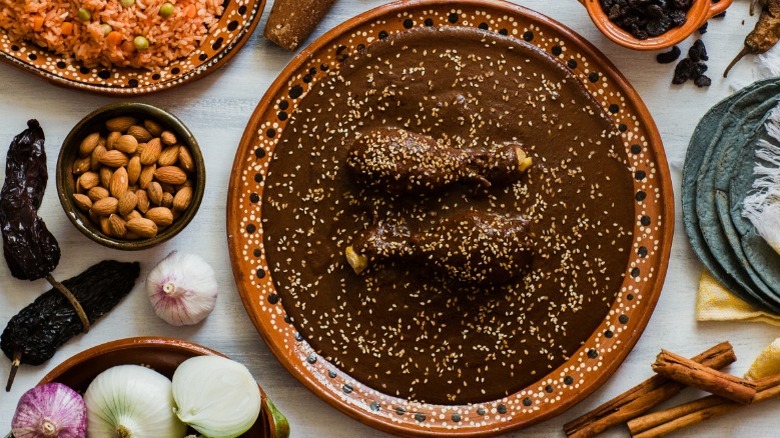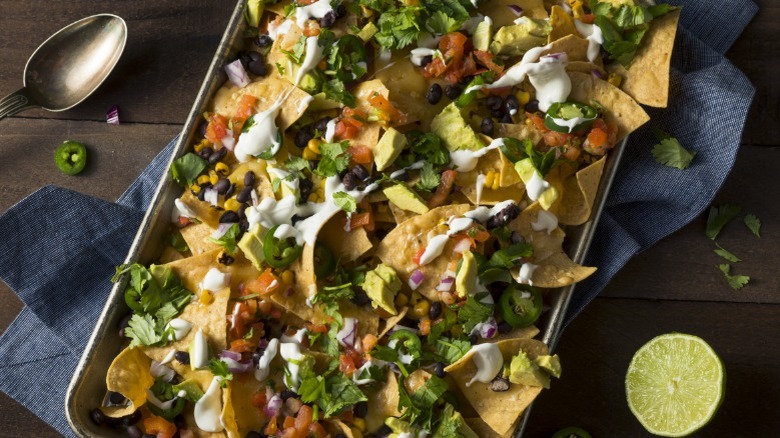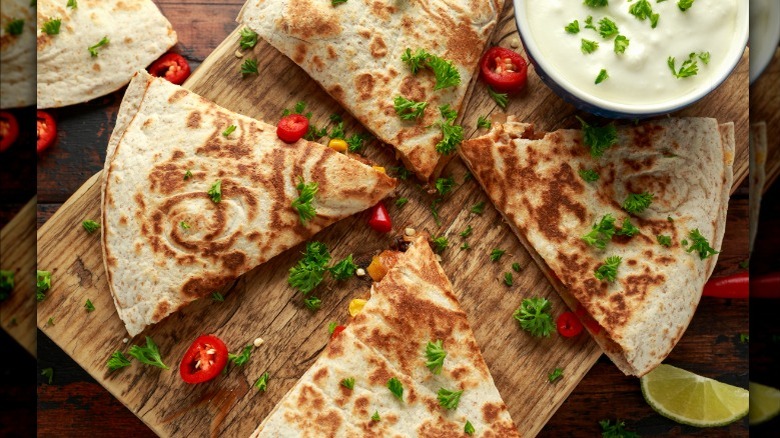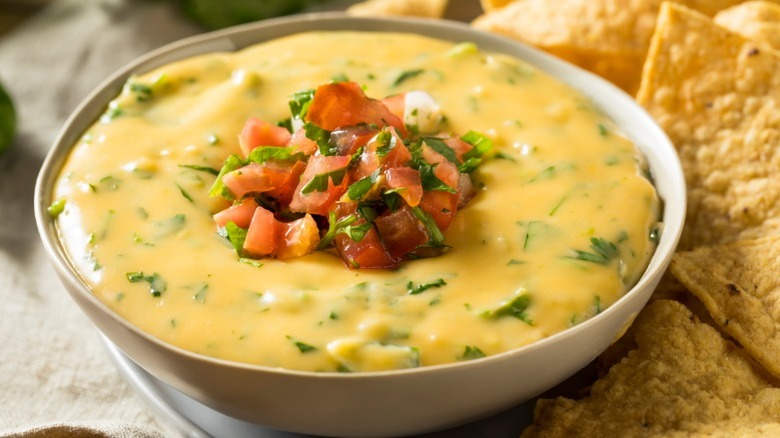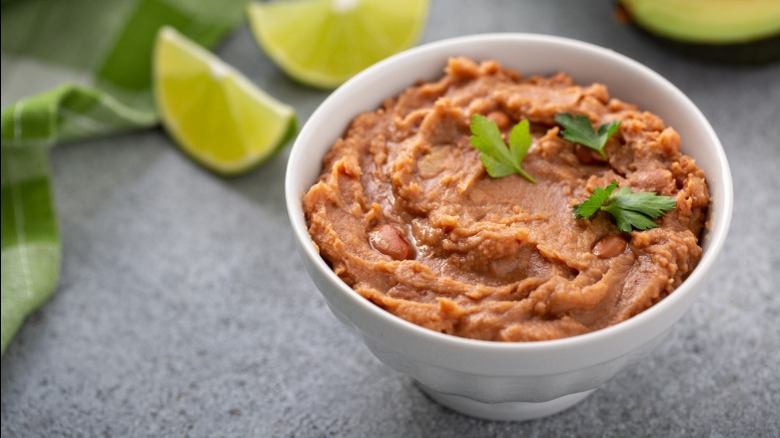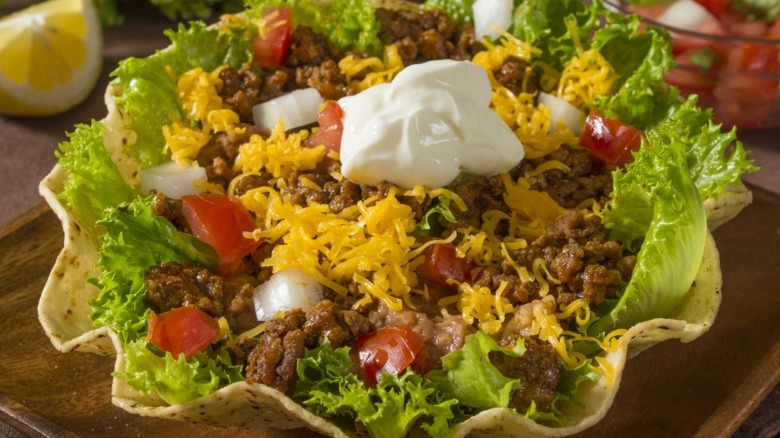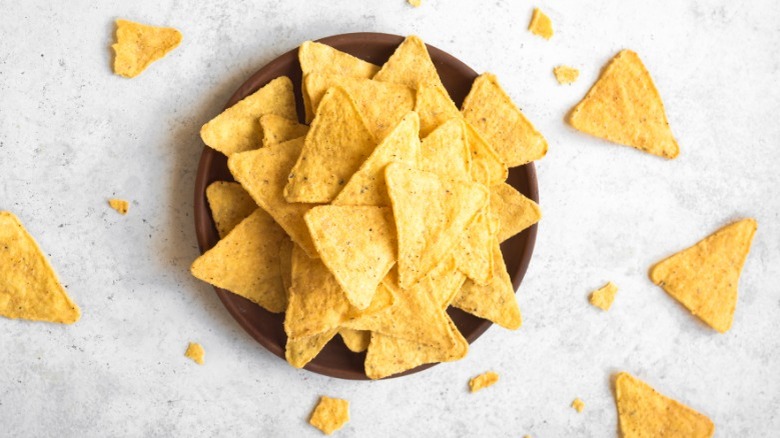14 Foods You May Want To Skip At A Mexican Restaurant
Before you get carried away thinking that we're disparaging any of these foods, please know that we love most of them. Wholeheartedly. And we encourage you to eat whatever it is that sets your tastebuds alight. However, if you find yourself at an authentic Mexican restaurant and find yourself flummoxed and about to order the same old, let us give you a reason to try something new. We've also tried to keep in mind that every situation is different and, yes — sometimes you just want a burrito, man.
The majority of items on this list fall into two categories — Tex-Mex or just not worth the expense. And let's get one thing clear: We love Tex-Mex, a regional cuisine that started to appear in Texas after the end of the American Civil War. A fusion of Mexican flavors and American ingredients, it spawned some iconic dishes including chili con carne, fajitas, and quesadillas. But if you're dining someplace that has the goods, meaning truly authentic Mexican food, why not give it a shot?
Burritos
Did you know that "burrito" means little donkey in Spanish? Those over-stuffed, grab-and-go, foil-wrapped handfuls could be named for their squat stature and for the amount of stuff they can hold. And that brings us to our biggest complaint about burritos — the amount of rice used to fill them up to bulging capacity. Rice is used so that the other tastier (and far more expensive) ingredients can be used sparingly. In fact, burrito-business leader Chipotle encourages employees to use less of the "critical seven" ingredients, according to Noteably. This includes all the meats, cheese, sour cream, and avocado. You know, the good stuff.
The amount of rice used in these Tex-Mex handfuls will also dampen the flavor of anything else added. And if you're into Mexican food, you're not looking to have any of those bright flavors reduced, right? It is possible to find burritos in parts of northern Mexico, but that's only because of the proximity to California, where the dish originated in the 1930s (via The Food We Know). It is possible that Sonoran miners invented something close to the burrito by using tortillas to wrap their dinner for easy transportation, but those meals were leagues away from the burritos served now.
Ceviche
The biggest problem with ceviche is, well ... it's ceviche. If you're unfamiliar with this dish, let us enlighten you. First of all, it is a truly delicious dish. However, the method of cooking requires a pretty strict time limit. Ceviche is a seafood soup that isn't heated — rather, it uses a citrus marinade to "cook" the fish. While this results in an incredibly flavorful and tender bowl of seafood, there is a problem with the timing here. Per Serious Eats, J. Kenji Lopez-Alt recommends a marinade of about 30 minutes. Any more than that and you'll end up with tough, rubbery, pickled fish.
The problem with ceviche is the method of preparation, but also the need for truly fresh and high-quality seafood. Because the dish has to be prepared as the diner orders it, the restaurant has to be using the highest quality seafood and keeping it on ice until time to start the marinade. If you're dining somewhere that doesn't specialize in seafood, it might not be the best choice. Unless you absolutely trust the restaurant beyond a shadow of a doubt, give this spectacular dish a pass until you find something more authentic.
Chili con carne
This entry might not surprise you, but chili con carne definitely isn't an authentic Mexican dish. It does have an interesting backstory and deserves its place in the annals of Tex-Mex culinary and feminist history. Shortly after the American Civil War, women known as "chili queens" set up stalls in the open-air markets of San Antonio, selling hot food to laborers and the wealthy alike, in order to support their families, according to Texas Monthly. This dish was a riff on a meal made by cowboys sleeping under the stars who stewed dried meat with tomatoes and chilies.
Chili con carne is delicious, for sure. But again, it's a Tex-Mex creation and not a truly authentic Mexican dish. Foodwiki asserts that the Tex-Mex category of food owes a great deal to those chili queens who introduced Mexican flavors to the American south. In fact, the dish is so inextricably tied to the state that in 1977 legislators lobbied to have the dish proclaimed the official "state food" of Texas, according to Where Texas Became Texas. So, while it's a very tasty and satisfying dish that has been around forever, it's definitely not an authentic Mexican dish. Find yourself someplace in Texas and try the real deal instead.
Chimichangas
Much like its cousin, the burrito, chimichangas aren't at the top of our list for incredibly tasty or authentic Mexican dishes. Basically a deep-fried burrito, you've taken all the things we dislike about burritos and then added on 1,000 more calories. No shame there, certainly ... but nutritionists agree that it's one dish you should never order. While you're in charge of your nutritional needs, this is a meal that just doesn't seem worth it.
Chimichangas aren't even known for being particularly tasty. It's a dish filled with rice, meat, and cheese, deep-fried, and covered with more cheese. Not to mention that deep frying takes one of the things we love about a burrito — that pillowy, fresh tortilla — and fries it until it's a crunchy shell of its former self. So if you're really, really craving a meat and cheese feast, by all means, stop at a food truck, pick up a burrito, and revel in the soft tortilla and fresh flavors. Or, even better, hit your local Mexican place and discover tostadas or flautas, two authentic dishes that will quell any deep-fried craving superbly. If you're going to do it, do it as deliciously as possible.
Fajitas
Fajitas are beloved by so many of us, so how can they land on a list like this? Simply put, if you're going to a good Mexican restaurant and ordering fajitas, you're just missing the point. It's a dish that isn't particularly Mexican, as it was originally eaten by Texan cowboys and Mexican pancheros working north of the border (via History). As with chili or enchiladas, this doesn't mean it's a lesser dish by any means — it simply means that it's another Tex-Mex entry rather than something authentically Mexican.
Perhaps more important, however, is the fact that you're not always getting even an authentic Tex-Mex fajita. Traditionally made with skirt steak — which is a tougher cut that boasts a luscious beefy flavor — many restaurants will rely on a cheaper cut that needs to be tenderized quickly, rather than with a marinade. And since fajitas use so few ingredients, it only makes sense to use the ingredients with the best flavors. Speaking of those few ingredients, that might be another reason you'll want to skip ordering it. Pick up a piece of skirt steak, a few peppers, and some fresh tortillas, and you've got yourself the makings of a better (and cheaper) fajita feast.
Guacamole
So, yes ... it's true that some upscale Mexican restaurants are known for their tableside guac service. And if you're a true avocado aficionado, then go for it. But in your average Mexican cantina, a $10 bowl of guacamole is nearly a sin, especially when most of us are sufficiently skilled to make it ourselves. Think of this as a financial intervention for those of you who still dream of buying a house. Avocados are fickle beasts, sure. But once you understand it, you can be churning out fresh green guac at a moment's notice. Sure, avocados are expensive, but buying them in restaurants is anxiety-inducingly expensive.
Treat yourself to a big old guac and chips party without breaking the bank with this crave-worthy guac recipe, and brush up on the things you shouldn't be doing to those precious alligator apples. But let's get down to the outrageous cost of that delish addition. It's simple, really. Avocados are a high-commodity item, meaning that it costs a lot to grow (it requires an enormous amount of water and work) with only a short window of growth.
Margaritas
Possibly the most iconic cocktail accompaniment for Mexican food, the margarita might not always be the best choice in a restaurant. A true margarita, made with fresh, quality ingredients is an out-of-this-world experience that combines sweet, salty, and tangy all at once. So how can you tell if the margarita you're thinking about ordering is worth it? First, if you can see a frozen margarita machine on the bar, skip it. The cocktail will likely be loaded with corn syrup and artificial flavoring, making it less than optimal.
An authentic Mexican margarita should be made with freshly squeezed lime juice, simple syrup (or agave), good quality tequila, and Grand Marnier or Cointreau. While bartenders sometimes argue over the proportions of the cocktail, we like this recipe that uses the 2-1-1 ratio for spirits and lime juice. A simply salted rim and rocks glass full of ice and you're done. Finally, don't be tempted by the lure of a "Cadillac" margarita promising luxury ingredients and special touches that you won't find with the original version. You'll gain some flamboyant high-roller cred sure, but the taste of that premium tequila will be obscured by cheap, overly complicated ingredients.
Mole
This one can be tricky, so hang on. If you've ever had a homemade bowl of incredibly sumptuous mole, then you'll know that there are honestly few things better. The Curious Mexican likens it to another famous dish, curry, in that every family has their own well-guarded and beloved recipe. Mole is so labor-intensive that it's most often made for special occasions like weddings when a number of family members are around to help out.
And on top of that, there are regional differences that will complicate things even further. Those regional differences are one of the reasons that mole can differ so much between restaurants. But that's not why we're cautioning you to take moment before ordering mole. The main thing to remember is just how complicated and time-consuming the recipes can be. Most likely, you'll be getting a mole using a pre-made paste that will never compare to the real thing. So, unless you know that restaurant very well, we advise you to skip the quasi-mole until you can try the real thing.
Nachos
Please don't misunderstand — we love nachos. Everybody loves nachos. But if you're seated at a table in an authentic Mexican restaurant with handmade hot sauces and fresh tortillas, you better not be ordering nachos, broadly speaking. Another Tex-Mex creation, nachos just fall short when you could be enjoying something so much tastier like a plate of sopes (mini corn masa dishes that hold a scoop of refried beans, cheese, and other savory toppings). Nachos get soggy quickly and there's always that one friend that eats all the cheesiest chips with little regard for anyone else.
Like a number of other dishes on this list, we just think you'd be better off making them at home. That way, you can customize the toppings and it's going to be a lot cheaper. And we have a simple tip to help thwart that cheese-hogging friend, too. A big sheet pan for starters. Then a layer of chips, followed by a layer of cheese and toppings. Then more layers. Genius, right? You can even pop the tray into the oven after adding each layer to make sure all that cheese gets properly melted.
Quesadillas
We'll never say anything against quesadillas. It's the beloved Tex-Mex version of grilled cheese that even kids will eat. A plate of cheesy triangles is always sure to please. But again, like fajitas and guacamole, if you're ordering it at a Mexican restaurant, you might just be missing out on better options. Make them at home with this easy recipe and save restaurant night for something really special, like chiles rellenos (a magical appetizer made of cheese-stuffed poblano peppers, coated in a light batter, and deep-fried) instead.
If you've got your heart set on the tasty snack that is quesadillas, then take a few things into account before ordering. The best thing you can do for yourself is to ensure that your restaurant is using fresh, handmade tortillas. Those bagged grocery store babies can't hold up to the fresh ones. As for the fillings in that restaurant quesadilla, make sure that you're getting decent cheese and preferably two different types — a creamy one and a melty one for maximum flavor. One caveat to ordering a restaurant quesadilla, however, is that it can usually be counted on to be a relatively decent choice at a bar or any establishment that doesn't really specialize in food. They're usually cheap, hard to screw up, and you probably won't regret it in the morning compared to soggy fries or pickled eggs.
Queso dip
Like so many entries on this list, queso is another food that we're crazy about but wouldn't order. Per Eater, queso dip and warm tortilla chips are almost the mascots for Tex-Mex foods, and for good reason. The melty cheese infused with chile peppers and the crisp tortilla chips is a combination to dream about. However, they might be worth passing over the next time you go to your favorite Mexican restaurant if authentic food is what you're after.
The dish, it turns out, is often just not worth the money. In Mexico, soft or melting cheeses like queso asadero are most often used in warm dishes to provide creaminess. However, since the 1920 creation of queso dip in San Antonio, Texas, the basic ingredient has been American cheese. Yes, the processed, wiggly stuff with the beguiling bright orange hue. Again, it's also super easy to make at home and we don't blame you if you do, there's a reason that it's such an adored snack. We just think that you might benefit from trying something a little more authentic when you've got the chance.
Refried beans
Another cheap option that's mostly meant to fill out dishes using more expensive ingredients, refried beans have long been maligned as unhealthy. So let's get that out of the way right off the bat. Refried comes from the Spanish word "refritos" which just means "well-fried." So, according to Grammaphobia, they're just leftover cooked beans that get mashed and reheated with a good amount of lard — so they're actually fried only once. But they are mixed with lard and can be pretty heavy, so a big bowl of tortilla chips and refried beans might not be the way to go, as far as appetizers are concerned. Delicious, sure, yet also incredibly heavy and filling.
Okay, so you're down with a heavy app. We're not here to judge. However, you might be shocked to learn that lots of places just empty a can of refried beans (like that cranberry jelly on Thanksgiving) and heat it up. Not as appetizing, is it? Probably not. And don't even get us started on why you shouldn't be eating Taco Bell's refried beans. They'd be lucky to come from a can, is all we have to say.
Taco salads
A staple of 1990s menus, when we all started to broaden our culinary horizons, the taco salad is something you should probably never order — in a Mexican restaurant or anywhere else. According to Mexican cookbook author Pati Jinich, the taco salad was first popularized by Doritos creator Elmer Doolin in the 1960s (via The Washington Post). That first iteration was little more than a deep-fried Dorito bowl filled with ground meat, cheddar cheese, and sour cream — what Jinich describes as the typical North American ideal of Mexican food at the time. She goes on to say that while it was an important moment in Tex-Mex history, it's certainly not the salads that Mexicans are eating.
Not only are restaurant tacos salads a weird hybrid of ingredients, they're not a typical ensalada made in most home kitchens in Mexico. Those salads use fresh local ingredients, creamy dressings or tart vinaigrettes and aren't served in a fried bowl. If you're still craving leafy greens and refried beans, we won't stand in your way. Setting up a Tex-Mex style salad bar in your own kitchen is likely the better way to go. Customize veggies and toppings, and use fried tortilla strips to make it a healthier option without risking indigestion.
Tortilla chips
We think you can guess why we're giving this one the thumbs down, right? Free chips are one thing, like those baskets of warm bread at other restaurants — unnecessary, yet totally irresistible. But that's not what we're talking about here. It's almost unconscionable for a Mexican restaurant to have tortilla chips on the menu and even worse if you're considering ordering and paying for them. SFGate reports that tortilla chips (or totopos in Spanish) and salsa are usually a part of the large Mexican meals that North Americans regularly eat.
The article goes on to say that where things get sticky, calorie-wise, is the difference between portion and serving sizes. The portion is the amount the restaurant gives you, while a serving is the recommended amount you should eat to stay healthy. A restaurant portion could easily exceed one serving, especially if they're offering you bottomless chips and salsa. The other qualm we have with ordering a bowlful of tortilla chips just comes down to cost. Like a few other items on this list, it's so simple to enjoy at home without paying premium prices. Save your hard-earned cash for ordering something truly outstanding for your meal and pass on the mediocre appetizer.
